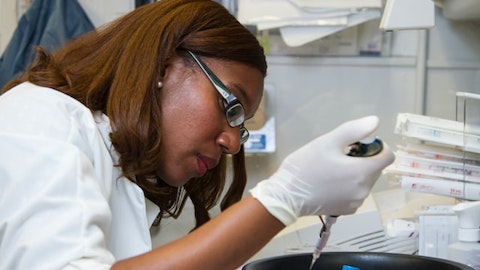Igor Bilinsky: Yes. So as you know, in case of CAR-T, we’ve seen that happen, in some cases, to an extreme extent. In our case, we’ve had the manufacturing success rate maintained in the clinic at more than 90% consistently. And in the pivotal cohort, it was 94.7%. The final specs will be set very late at approval. So we cannot comment on the final specs right now, but that’s certainly been part of the discussions with the agency and part of the information requests that have been ongoing. But we don’t expect — I mean, right now, we don’t expect anything as anywhere close as draconian as you’ve seen, in some cases, of CAR-T in terms of tightening this mix.
Operator: Our next question comes from Ben Burnett with Stifel.
Benjamin Burnett: I wanted to go back and ask another question about just the capacity. I understand that the FDA will sort of help define the capacity at launch just in terms of the number of slots that are available for commercial use. But I guess can you frame for us just maybe like an upper limit of the capacity that you feel like you can handle now?
Frederick Vogt: Yes, Ben, the facility right now is actually constructed to go even beyond 2,000 patients a year at our facility. And then on top of that, we have our CDMO, Wuxi that has considerable capacity until we haven’t disclosed exactly what that is, but it’s quite large. It could represent a good portion of our capacity at launch. So that’s really the max that we’ve got constructed today without the need for additional capital.
Benjamin Burnett: And does that include like the personnel required to sort of run that type of capacity at that level?
Frederick Vogt: Yes. The majority of that personnel is in place and the rest of it can be put in place very quickly. Obviously, we don’t just sit the personnel there as a fixed cost, if we don’t need to, but we are very well skilled in bringing on manufacturing and QC personnel quickly and know how to do that in both Iovance and at our CDMO.
Benjamin Burnett: And then maybe just one other question. Just I guess can you frame for us when one would expect the labeling discussions to start? Would this be something at the late cycle meeting has been the first ever sort of TIL [indiscernible] just any color you can provide on that?
Raj Puri: Yes. As I mentioned earlier, thanks for asking this question, that labeling discussion has actually begun. We have received a couple of IRs clarifying things in the label. So — and it’s going to continue until they perhaps earlier approval date. So it’s a good news for us that we have already engaged with the agency delivering discussions.
Operator: [Operator Instructions]. Our next question comes from Kelsey Goodwin with Guggenheim.
Kelsey Goodwin: Just a couple of quick ones for me. I guess, maybe just on ex U.S., is this still something that you’re looking to pursue on your own? And I guess, is there any appetite to maybe partner in specific regions or just more broadly ex U.S.? And then moving on to the endometrial cancer trial, I guess, maybe could you just remind us what kind of the efficacy benchmark is in the post-PD-1 setting here?
Frederick Vogt: Yes, I can answer the first one, Kelsey and then Friedrich can jump in on the second part on the endometrial benchmarks. So we’re always looking for opportunities. And yes, we would consider things like partnerships, strategic alliances and things like that. But right now, we do have the ability to go into these jurisdictions ourselves if needed, and we can do that with minimal capital investments right now as we discussed on the earlier part of the call, we don’t need to build a facility there. We don’t need to really do a whole lot of hiring there. We can get in there and generate revenues relatively quickly. Now it turns out there’s a partnership that would be of value to our shareholders. Certainly, we would consider that in those jurisdictions. But right now, we’re looking to do it ourselves as well. And then, Friedrich, can you answer the endometrial benchmark question?




